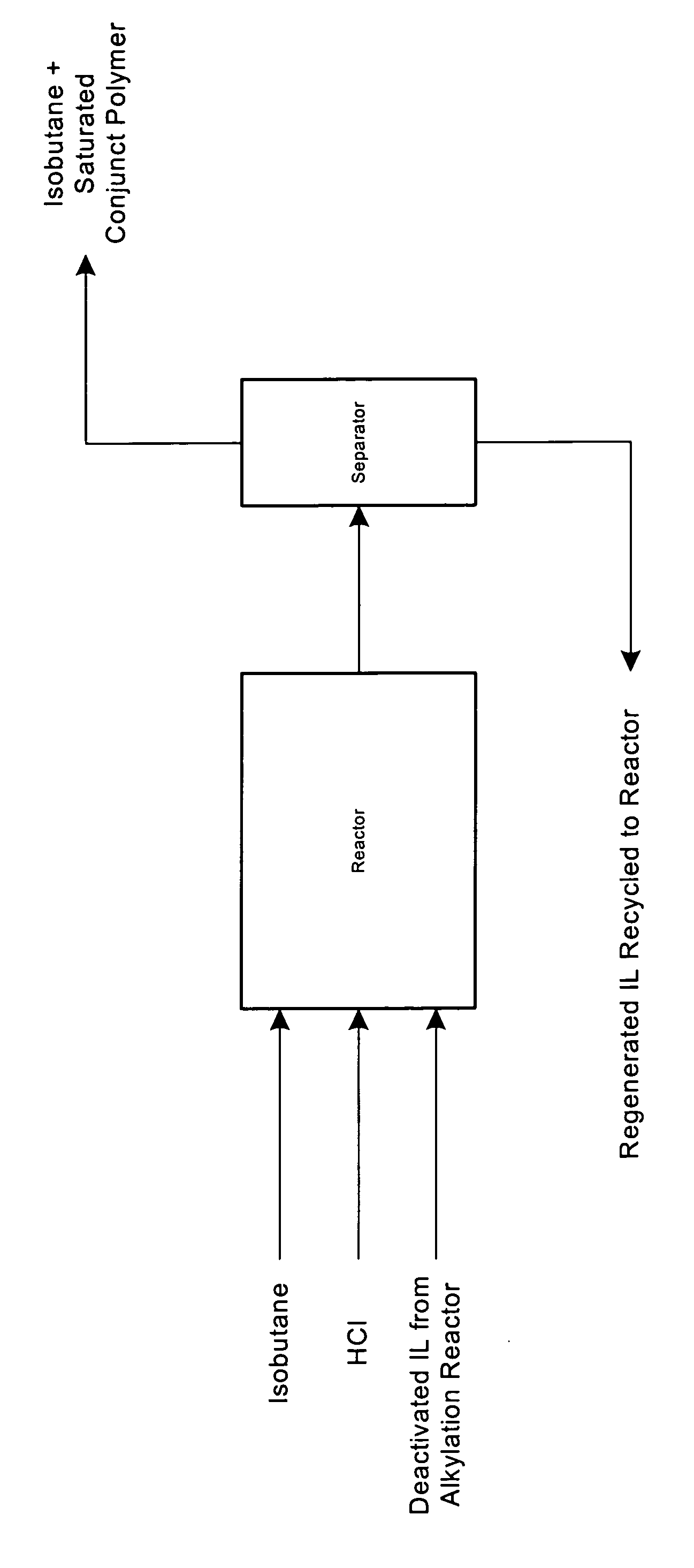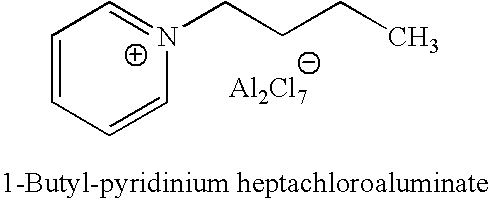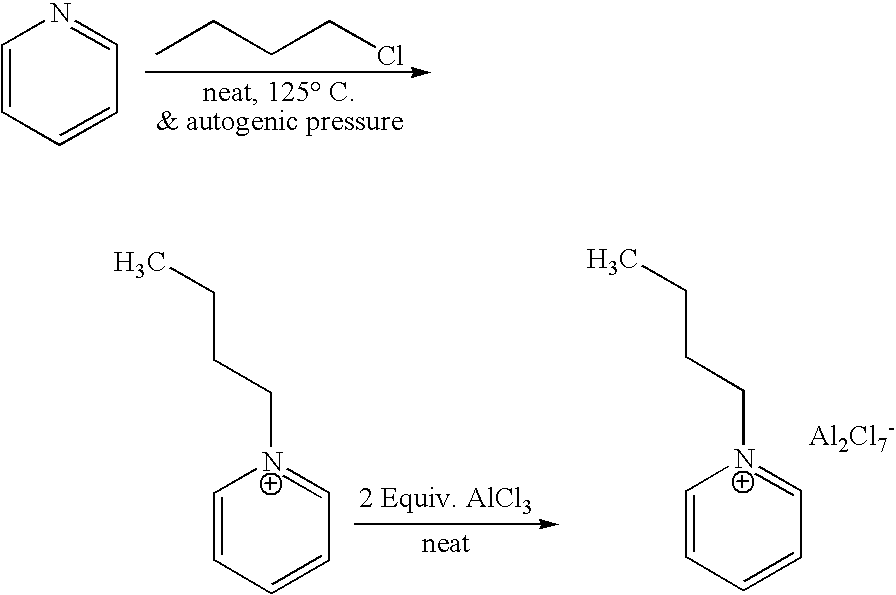Regeneration of ionic liquid catalysts
a technology of ionic liquid and catalyst, which is applied in the field of regeneration of catalysts, can solve the problems of deactivation loss of activity, and need to be replaced, and achieve the effect of increasing the activity of ionic liquid catalys
- Summary
- Abstract
- Description
- Claims
- Application Information
AI Technical Summary
Benefits of technology
Problems solved by technology
Method used
Image
Examples
example 1
Preparation of Fresh 1-Butylpyridinium Chloroaluminate Ionic Liquid Catalyst A (Fresh IL A)
[0035] 1-butyl-pyridinium chloroaluminate is a room temperature ionic liquid prepared by mixing neat 1-butyl-pyridinium chloride (a solid) with neat solid aluminum trichloride in an inert atmosphere. The syntheses of butylpyridinium chloride and the corresponding 1-butyl-pyridinium chloroaluminate are described below. In a 2-L Teflon-lined autoclave, 400 gm (5.05 mol.) anhydrous pyridine (99.9% pure purchased from Aldrich) were mixed with 650 gm (7 mol.) 1 -chlorobutane (99.5% pure purchased from Aldrich). The autoclave was sealed and the neat mixture allowed to stir at 125° C. under autogenic pressure over night. After cooling off the autoclave and venting it, the reaction mix was diluted and dissolved in chloroform and transferred to a three liter round bottom flask. Concentration of the reaction mixture at reduced pressure on a rotary evaporator (in a hot water bath) to remove excess chlor...
example 2
Preparation of “Deactivated” 1-Butylpyridinium Chloroaluminate Ionic Liquid Catalyst (Deactivated Catalyst A)
[0037]“Deactivated” or “used” 1-butylpyridinium chloroaluminate ionic liquid catalyst was prepared from “fresh” 1-butylpyridinium chloroaluminate ionic liquid catalyst by carrying out the isobutane alkylation reaction in a continuous flow microunit under catalyst recycle with accelerated fouling conditions.
[0038] The microunit consists of feed pumps for isobutane and butenes, a stirred autoclave reactor, a back pressure regulator, a three phase separator, and a third pump to recycle the separated ionic liquid catalyst back to the reactor. The reactor was operated at 80 to 100 psig pressure and with cooling to maintain a reaction temperature of ˜10° C. To start the reaction, isobutane, butenes, and HCl were pumped into the autoclave at the desired molar ratio (isobutane / butenes>1.0), through the back pressure regulator, and into the three phase separator. At the same time, f...
example 3
Determination of the Amounts of Conjunct Polymer and Olefin Oligomers in Deactivated IL A
[0041] The wt % of conjunct polymers in the spent (deactivated) ionic liquid was determined by hydrolysis of known weights of the spent catalyst. The example below is a typical procedure for measuring conjunct polymers in a given spent catalyst. In a glove box, 15 gm of a spent ionic liquid catalyst in a flask were rinsed first with 30-50 ml of anhydrous hexane to remove (from the spent catalyst) any residual hydrocarbon or olefinic oligomers. The hexane rinse was concentrated under reduced pressure to give only 0.02 gm of yellow oil (0.13%). Then, 50 ml of anhydrous hexane was added to the rinsed catalyst followed by slow addition of 15 ml of water, and the mixture was stirred at 0° C. for 15-20 minutes. The resulting mixture was diluted with additional 30 ml hexanes and stirred well for additional 5-10 minutes. The mixture was allowed to settle down to two layers solution and some solid resid...
PUM
| Property | Measurement | Unit |
|---|---|---|
| Temperature | aaaaa | aaaaa |
| Temperature | aaaaa | aaaaa |
| Time | aaaaa | aaaaa |
Abstract
Description
Claims
Application Information
 Login to View More
Login to View More - R&D
- Intellectual Property
- Life Sciences
- Materials
- Tech Scout
- Unparalleled Data Quality
- Higher Quality Content
- 60% Fewer Hallucinations
Browse by: Latest US Patents, China's latest patents, Technical Efficacy Thesaurus, Application Domain, Technology Topic, Popular Technical Reports.
© 2025 PatSnap. All rights reserved.Legal|Privacy policy|Modern Slavery Act Transparency Statement|Sitemap|About US| Contact US: help@patsnap.com



